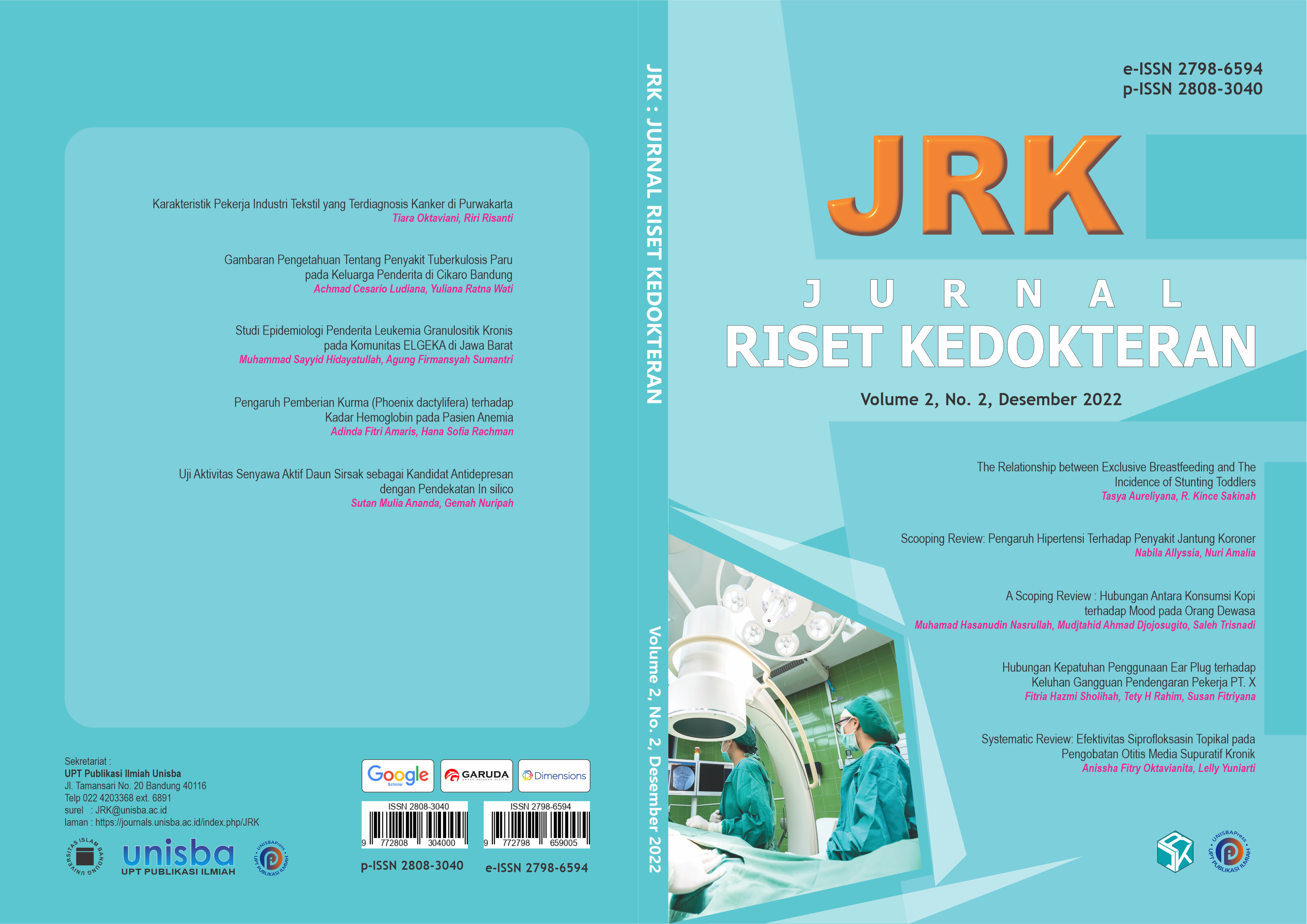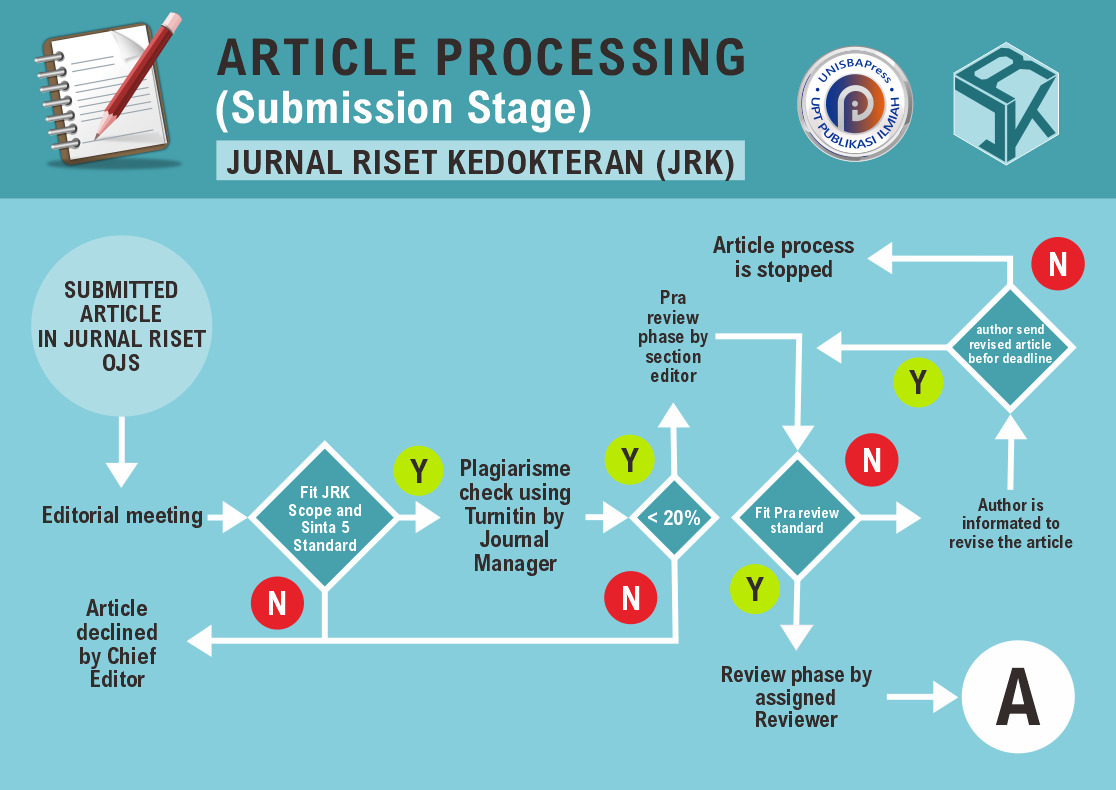Studi Epidemiologi Penderita Leukemia Granulositik Kronis pada Komunitas ELGEKA di Jawa Barat
DOI:
https://doi.org/10.29313/jrk.vi.1536Keywords:
Epidemiologi, Komunitas ELGEKA, Leukemia Granulositik KronisAbstract
Abstract. This research is a descriptive observational study, with a cross sectional research design. The number of subjects in this study was 63 people. The selection of subjects using non-probability purposive sampling techniques or research subjects met the inclusion criteria, using the Slovin formula. Data analysis using the SPSS statistical application. The characteristics to be described include domicile, age, sex, occupation, race, age at diagnosis, latest education, medication, initial and final BCR-ABL values, leukocytes, platelets and hemoglobin. The results showed the highest prevalence was in Bandung (20%), with an age range of 30-39 years (38.1%), suffered mostly by women (55.6%), most of them were private employees (28.6%), people with Sundanese race (68.3%), the average age of diagnosis was 34 years, the latest education was higher education graduate (57.1%), the most drug used was imatinib (81.3%), the initial dominant BCR-ABL value was > 10% and end dominant was < 0.1%, the results of a routine dominant hemoglobin blood test were 8-12 g/dL, the results of dominant leukocytes were 5000-10,000/mm3, and the yield of dominant platelets was 150,000 to 400,000 mm3.
Abstrak. Penelitian ini bertujuan untuk mendiskripsikan karakteristik penderita leukemia granulositik kronis pada komunitas ELGEKA Jawa Barat. Penelitian ini adalah sebuah penelitian deskriptif observasional, dengan desain penelitian cross sectional. Jumlah Subjek dalam penelitian ini adalah 63 orang. Pemilihan subjek dengan teknik non probability purposive sampling atau subjek penilitian memenuhi kriteria inklusi, menggunakan rumus slovin. Analisis data menggunakan aplikasi statistik SPSS. Karakteristik yang akan digambarkan meliputi domisili, usia, jenis kelamin, pekerjaan, ras, usia diagnosis, pendidikan terakhir, pengobatan, nilai BCR-ABL awal dn akhir, leukosit, trombosit dan hemoglobin. Hasil menunjukan bahwa pravelensi tertinggi berada di Kota Bandung (20%), dengan rentang usia 30-39 tahun (38,1%), jenis kelamin terbanyak wanita (55,6%), pekerjaan terbanyak pegawai swasta (28,6%), Ras terbanyak sunda (68,3%), usia rata-rata diagnosis 34 tahun, pendidikan terakhir perguruan tinggi (57,1%), penggunaan obat terbanyak imatinib (81.3%), nilai BCR-ABL awal dominan >10% dan akhir dominan <0,1%, hasil pemeriksaan darah rutin dominan hemoglobin 8-12g/dL, leukosit dominan dengan hasil 5000-10.000/mm3 dan trombosit dominan dengan hasil 150.000-400.000 mm3.
References
R. L. G. Hechavarría, “Chronic Myeloid Leukimia,” J. Chem. Inf. Model., vol. 53, pp. 1689–1699, 2013.
Reksodiputro A H, “Epidemiology Study and Mutation Profile of Patients with Chronic Myeloid Leukemia (CML) in Indonesia,” J Blood Disord Transfus, vol. 6, no. 3, pp. 1–13, 2015.
A. O.-A. W. O. M. J. D. M. M. A. O. P. O. S. A. M. Nicholas, “Exploring Occupational and Familial Risks for Chronic Myeloid Leukaemia,” J US-China Med Sci, vol. 14, no. 1, 2017.
J. M. M. Kuan, “The epidemiology of chronic myeloid leukaemia in southern Sarawak, Borneo Island,” Med J Malaysia, vol. 73, no. 2, pp. 78–85, 2018.
A. S. S. R. G. M. F. J. J. H.-H. H. Hochhaus, “Chronic myeloid leukaemia: ESMO Clinical Practice Guidelines for diagnosis, treatment and follow-up,” Ann Oncol, vol. 28, no. 4, pp. 41–51, 2017.
E. K. H. Jabbour, “Chronic myeloid leukemia: 2020 update on diagnosis, therapy and monitoring,” Am J Hematol, vol. 95, no. 6, pp. 691–709, 2020.
F. A. F. Algahtani, “Evaluation and characterisation of Chronic myeloid leukemia and various treatments in Saudi Arabia: A retrospective study,” J Infect Public Heal., 2020.
D. B. S. B. U. G. Y. G. P. H. H. Kim, “Chronic myeloid leukemia in the Asia-Pacific region: Current practice, challenges and opportunities in the targeted therapy era,” Leuk Res, 2010.
Aini Agnia, “Tingkat Kepatuhan Pengobatan Pasien Fase Intensif Berdasarkan Karakteristik Pasien TB di Puskesmas X,” J. Ris. Kedokt., 2022.
ELGEKA K, “Sejarah Komunitas ELGEKA [Internet],” 2006.
A. O. A. W. I. V. P. R. R. Sumantri, “Therapeutic Responses of Imatinib and Nilotinib among CML Patients in Hasan Sadikin Hospital Bandung,” Indones J Cancer, vol. 12, no. 3, p. 88, 2019.
W. H. A. T. H. H. K. Rajabto, “Hubungan Gambaran Klinis dan Laboratorium Hematologis antara Leukemia Granulositik Kronik Ph (+)/BCR-ABL (+) dengan Bentuk Kelainan Ph/BCR-ABL Lainnya,” J Penyakit Dalam Indones, vol. 5, no. 1, p. 11, 2018.
P. A. K. O. B. V. V. G.-G. P. H. H. Levine, “Demographic factors related to young age at diagnosis of chronic myeloid leukemia in India,” Clin Epidemiol Glob Heal, 2016.
J. A. A. A. S. E. M. Jm, “Haematological and cytogenetic changes in CML patients treated with imatinib mesylate in Western Libya,” 2019.
F. S. G. C. M. U. B. Y. A. Sahin, “Turkish Chronic Myeloid Leukemia Study: Retrospective Sectional Analysis of CML Patients,” Turkish J Hematol, vol. 30, no. 4, pp. 351–8, 2013.
W. das; B. A. de; V. A. M. F. de, B. M. R. Neves, “Incidence and spatial distribution of Chronic Myeloid Leukemia by regions of economic development in the state of Pernambuco, Brazil,” Hematol Transfus Cell Ther [Internet], 2019.
P. S. F. S. S. C. A. F. S. M. M. Vigneri, “High BCR–ABL/GUSIS levels at diagnosis of chronic phase CML are associated with unfavorable responses to standard-dose imatinib,” Clin Cancer Res, 2017.
A. S. A. M. B. S. H. A. M. M. I. A. M. U. S. A. Ahsan, “Characteristics of chronic myeloid leukemia: an observational study highlighting the correlation of age with hematological parameters,” pp. 10–4, 2018.













